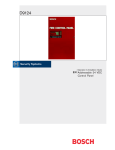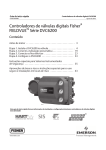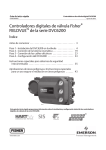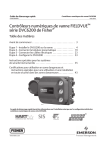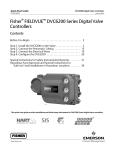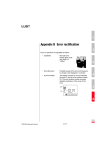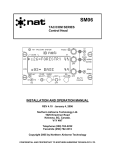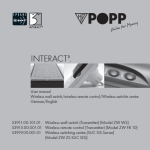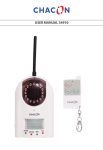Download Anodyne Electronics Manufacturing SM40 Specifications
Transcript
SPECIAL NOTICE This product is now licensed to Anodyne Electronics Manufacturing (AEM) from Northern Airborne Technology (NAT). AEM is responsible for all matters related to this product, including sales, support and repair services. Please note the transition to convert product manuals and supporting documentation is an ongoing process and is being addressed on an ‘as needed’ basis. All references to NAT product part numbers (and associated images) are equivalent to AEM product part numbers. Contact info: Anodyne Electronics Manufacturing Corp. #15-1925 Kirschner Road Kelowna B.C. Canada V1Y 4N7 Email: [email protected] Toll Free: 1-888-763-1088 Phone: 1-250-763-1088 Fax: 1-250-763-1089 www.aem-corp.com SM40 UT12-000 Universal Tone Encoder/Decoder INSTALLATION AND OPERATION MANUAL REV 5.00 May 15, 2012 Anodyne Electronics Manufacturing Corp. 15-1925 Kirschner Road Kelowna, BC, Canada. V1Y 4N7 Telephone (250) 763-1088 Facsimile (250) 763-1089 Website: www.aem-corp.com © 2012 Anodyne Electronics Manufacturing Corp. (AEM), All Rights Reserved CONFIDENTIAL AND PROPRIETARY TO ANODYNE ELECTRONICS MANUFACTURING CORP. UT12-000 Universal Encoder/Decoder SM40 Installation and Operation Manual COPYRIGHT STATEMENT © 2012 Anodyne Electronics Manufacturing Corp. (AEM), All Rights Reserved This publication is the property of AEM and is protected by Canadian copyright laws. No part of this document may be reproduced or transmitted in any form or by any means including electronic, mechanical, photocopying, recording, or otherwise, without the prior written permission of AEM. Installation and Operation Manual Page ii ENG-FORM: 820-0100.DOTX CONFIDENTIAL AND PROPRIETARY TO ANODYNE ELECTRONICS MANUFACTURING CORP. UT12-000 Universal Encoder/Decoder SM40 Installation and Operation Manual Prepared By: Checked By: Tony Pearson Designer May 15, 2012 Approved By: Tom Betzelt Product Support Manager June 11, 2012 Loen Clement Designer Jun 07/12 The status of this installation and operation manual is controlled by the revision shown on the title page. The status of each section is controlled by revision shown in the footer of each page. All revisions affecting sections of this manual have been incorporated. AEM MANUAL REVISIONS Section Revision Number Revision Description Date All Rev: 5.00 Updated template May 15, 2012 Installation and Operation Manual Page iii ENG-FORM: 820-0100.DOTX CONFIDENTIAL AND PROPRIETARY TO ANODYNE ELECTRONICS MANUFACTURING CORP. UT12-000 Universal Encoder/Decoder SM40 Installation and Operation Manual Table of Contents Section Title 1.0 Description 1.1 1.2 1.3 1.4 1.4.1 1.4.2 1.4.3 Introduction Purpose of Equipment Features Specifications Electrical Specifications Physical Specifications Environmental Specifications 2.0 Installation 2.1 2.2 2.2.1 2.3 2.3.1 2.3.2 2.3.3 2.3.4 2.3.5 2.4 2.5 2.6 Introduction Unpacking and Inspection Warranty Installation Procedures Warnings Cautions Cabling and Wiring Post-Installation Checks External Adjustments Continued Airworthiness Accessories Required But Not Supplied Installation Drawings 3.0 Operation 3.1 3.2 3.3 3.3.1 3.3.2 3.3.3 3.3.4 3.4 3.4.1 3.4.2 3.5 3.5.1 3.5.2 3.5.3 3.5.4 Introduction General Controls and Indicators MON (Monitor) Switch Alphanumeric Pushbuttons Function Pushbuttons Mode button Functions Data Entry Mode Operation Tones Mode Reception (Decoding) Receiving Regular Call Receiving Group Call: Receiving Alarm Call: Operation when the transceiver is scanning: Installation and Operation Manual Page 1-1 1-1 1-1 1-2 1-2 1-3 1-3 2-1 2-1 2-1 2-1 2-1 2-1 2-2 2-2 2-2 2-3 2-3 2-3 3-1 3-1 3-1 3-1 3-2 3-2 3-3 3-4 3-4 3-5 3-10 3-10 3-10 3-10 3-11 Page iv ENG-FORM: 820-0100.DOTX CONFIDENTIAL AND PROPRIETARY TO ANODYNE ELECTRONICS MANUFACTURING CORP. UT12-000 Universal Encoder/Decoder SM40 Installation and Operation Manual Section Title 3.6 3.6.1 3.6.2 3.7 3.7.1 3.7.2 3.8 3.8.1 3.8.2 3.8.3 3.8.4 Transmission (Encoding) Transmitting Regular Calls: Transmitting UT12’s ID sequence Tone Sequence Details LAM-LA-M Radionetwork AFN – Air Force Radionetwork Configuration Mode Unit Configuration Configurable Information Non-Configurable Information LAN/AFN Network Selection Installation and Operation Manual Page 3-12 3-12 3-12 3-12 3-13 3-13 3-14 3-14 3-14 3-15 3-15 Page v ENG-FORM: 820-0100.DOTX CONFIDENTIAL AND PROPRIETARY TO ANODYNE ELECTRONICS MANUFACTURING CORP. UT12-000 Universal Encoder/Decoder SM40 Installation and Operation Manual Section 1.0 Description 1.1 Introduction This manual contains information on the UT12-000 Universal Tone Encoder\Decoder. Information in this section consists of equipment, features and specifications. UT12-000 Universal Encoder\Decoder 1.2 Purpose of Equipment The UT12 is capable of encoding and decoding 5-tone CCIR tone sequences and encoding DTMF tones. It is compatible with the AEM Tac/Com control head will provide broader and easier control over tones. 1.3 Features System configuration data (such as identity codes) is programmed by use of front panel switches or by connecting the UT12 to an IBM-compatible PC through the serial data port. Front panel pushbutton controls are provided to allow the operator to perform the basic functions of entering, sorting, recalling and transmitting tone sequences, as well as allowing the entry of configuration data. The UT12 is capable of alerting the user to various system conditions through either an externally generated tone or by injecting a tone directly into the headphone audio line. The UT12 may also be used as a data entry pad for the Tac/Com control head, allowing quick selection of channels and entry of frequency data. Based on the configuration data, control head settings, and tone inputs, the UT12 is capable of turning on and off headphone audio from the transceiver to the head phone/audio controller. The UT12 will operate on both the LA-M/Health Network (LAM) and Air Force Network (AFN). Operation on each of the networks will be similar, with the exception of some differing 5-tone CCIR sequences. If the transmit frequency falls between 147 MHz and 154 MHz the UT12 will operate on the AFN Network, otherwise it will operate on the LAM Network. May 15, 2012 Rev: 5.00 Page 1-1 ENG-FORM: 800-0100.DOTX CONFIDENTIAL AND PROPRIETARY TO ANODYNE ELECTRONICS MANUFACTURING CORP. UT12-000 Universal Encoder/Decoder SM40 Installation and Operation Manual 1.4 Specifications 1.4.1 Electrical Specifications Input Power Nominal 28 Vdc @ < 1.5 A Max. 30.3 Vdc Min. 24.8 Vdc Emerg. 20.0 Vdc Input Signals Tone Audio: 300 mV into 1 kΩ Head phone Audio: 10 W max. Into 600 Ω Mic audio: 0 -1 Vrms PTT: Active low Output Signals Head phone Level, On: >1 dB from headphone audio input into 150 Ω Headphone Level, Muted: <-55 dB from headphone audio input into 150 Ω Microphone Audio, Tone Level: 0 – 1 Vrms into 150 Ω (adjustable.) Tone frequency error: < 0.5 % Tone types: CCIR, DTMF, Single PTT: Active low, 200 mA max. Alert key: Active low, 30 mA max. Miscellaneous Signals Tx Data Out: RS232C, 2400 baud Rx Data In: RS232C, 2400 baud Lighting +28 Vdc < 50 mAdc May 15, 2012 Rev: 5.00 Page 1-2 ENG-FORM: 800-0100.DOTX CONFIDENTIAL AND PROPRIETARY TO ANODYNE ELECTRONICS MANUFACTURING CORP. UT12-000 Universal Encoder/Decoder SM40 Installation and Operation Manual 1.4.2 1.4.3 Physical Specifications Height 1.50" (38.10 mm) Depth 6.2" (157.48 mm) 5.75” (146.05mm) behind panel Width 5.75" (146.05 mm) 5.00” (127.00 mm) behind panel Weight 1.02 lbs (544g) Mounting Dzus rail Material/Finish Aluminum/Conversion Coating Connector Filtered 37 pin male Dmin Lighting Acceptable for operation with NVG Gen III goggles Environmental Specifications Temperature: Operating Survival -30q C. to +60q C -55q C. to + 85q C Altitude 25,000 feet Humidity 95% Shock 12 g (all axes) Environmental categories RTCA/DO-160C Env. Cat. B4-BA(MN)XXXXXXABBZAUBXXX End of Section 1.0 May 15, 2012 Rev: 5.00 Page 1-3 ENG-FORM: 800-0100.DOTX CONFIDENTIAL AND PROPRIETARY TO ANODYNE ELECTRONICS MANUFACTURING CORP. UT12-000 Universal Encoder/Decoder SM40 Installation and Operation Manual Section 2.0 Installation 2.1 Introduction Information in this section consists of unpacking and inspection procedures, installation procedures, postinstallation checks, and installation drawings. 2.2 Unpacking and Inspection Unpack the equipment carefully. Inspect the unit visually for damage due to shipping and report all such claims immediately to the carrier involved. Note that each unit should have the following: - UT12 Universal Encoder/Decoder - Product Information Card - Release certification Verify that all items are present before proceeding and report any shortage immediately to your supplier. 2.2.1 Warranty All Anodyne Electronics Manufacturing Corp. (AEM) products are warranted for 2 years. See the website www.aem-corp.com/warranty for complete details. 2.3 Installation Procedures 2.3.1 Warnings Do not bundle any lines from this unit with transmitter coax lines. Do not bundle any audio or DC power lines from this unit with 400 Hz synchro wiring or AC power lines. Do not position this unit or wiring from this unit next to any device with a strong alternating magnetic field such as an inverter, or significant interference will result. 2.3.2 Cautions In all installations, use shielded cable exactly as shown and ground as indicated. Significant problems may result if these guidelines are not followed. May 15, 2012 Rev: 5.00 Page 2-1 ENG-FORM: 805-0100.DOTX CONFIDENTIAL AND PROPRIETARY TO ANODYNE ELECTRONICS MANUFACTURING CORP. UT12-000 Universal Encoder/Decoder SM40 Installation and Operation Manual 2.3.3 Cabling and Wiring All unshielded wire should be MIL-W-22759 or equivalent. For shielded wire applications, use Tefzel MILC-27500 shielded wire with solder sleeves (for shield terminations) to make the most compact and easily terminated interconnect. Follow the wiring diagrams in Section 2.6 as required. Allow 3 inches from the end of the wire to the shield termination to allow the hood to be easily installed. Note that the hood is a ‘clamshell’ hood, and is installed after the wiring is complete. All wiring should be at least 22 AWG, except power and ground lines, which should be at least 20 AWG. Ensure that all ground connections are clean and well secured. 2.3.4 Post-Installation Checks If any preset requires adjustment, be sure this is carried out before the aircraft leaves, and that the unit and its mating connector are secured before departure. Make all required log book entries, electrical load, weight and balance amendments and other paperwork as required by your local regulatory agency. 2.3.4.1 Voltage/resistance checks Do not attach the UT12 until the following conditions are met. Check the following: a) P101 pins <1> and <2> for +28 Vdc relative to ground. b) P101 pins <20> and <21> for continuity to ground (below 0.5Ω) 2.3.4.2 Power On checks Install the UT12 and power up the ship’s systems. Turn on the Universal Tone Encoder/Decoder. Verify normal operation of all functions. Refer to Section 3 for specific operation details. 2.3.5 External Adjustments The unit is shipped from the factory with all external adjustments set to the normal test levels. Once installed in the aircraft, it may be desirable to change some of these settings to best suit the local operating environment. The external adjustments are accessible through the right hand side of the unit and are as follows: CCIR LVL Adjusts the signal level of the CCIR tone sent to the transceiver. ALRT LVL Adjusts the signal level of the tone alert signal sent to the headset. DTMF LVL Adjusts the threshold level setting for determining a valid tone signal received transceiver. (Located on left side of unit). Upon satisfactory completion of all performance checks, make the required log entries and complete the necessary Regulatory Agency paperwork before releasing the aircraft for service. May 15, 2012 Rev: 5.00 Page 2-2 ENG-FORM: 805-0100.DOTX CONFIDENTIAL AND PROPRIETARY TO ANODYNE ELECTRONICS MANUFACTURING CORP. UT12-000 Universal Encoder/Decoder SM40 Installation and Operation Manual 2.4 Continued Airworthiness Maintenance of the UT12-000 is ‘on condition’ only. Periodic maintenance of this product is not required. 2.5 Accessories Required But Not Supplied Installation kit p/n D37SV-IKC is required to complete the installation. Each kit consists of the following: Quantity 1 37 1 2.6 Description AEM Part # D-min 37 Socket Housing MS Crimp Socket 37 Pin JVL Hood/Locklever 20-21-037 20-26-901 20-29-370 Installation Drawings DRAWING REV. DESCRIPTION TYPE UT12\000\403-0 1.01 Universal Tone Encoder/Decoder Interconnect UT12\000\905-0 1.01 Universal Tone Encoder/Decoder Faceplate UT12\000\908-0 1.00 Universal Tone Encoder/Decoder Adjustment Locator UT12\000\922-0 1.00 Universal Tone Encoder/Decoder Mechanical Section 2.0 ends following above documents May 15, 2012 Rev: 5.00 Page 2-3 ENG-FORM: 805-0100.DOTX CONFIDENTIAL AND PROPRIETARY TO ANODYNE ELECTRONICS MANUFACTURING CORP. UT12-000 Universal Encoder/Decoder SM40 Installation and Operation Manual Section 3.0 Operation 3.1 Introduction Information in this section consists of the functional and operational procedures for the UT12-000 Universal Tone Encoder/Decoder. 3.2 General The UT12 is capable of encoding and decoding 5-tone CCIR tone sequences and encoding DTMF tones. It is compatible with the NAT Tac/Com system, and when used in conjunction with a TH-series Tac/Com control head and NTX series transceiver it provides broader and easier control over radio communication. 3.3 Controls and Indicators 3.3.1 MON (Monitor) Switch: The monitor switch is a two position locking toggle switch that can select between OFF and ON. When in the Monitor OFF position, transceiver audio from the current channel (or home channel when scanning) is only heard if the correct tone ID sequence is decoded. When in Monitor ON position, transceiver audio from the current channel (or home channel when scanning) is always heard. The following functions are unaffected by the position of the MON Switch: Transceiver audio is always heard from the priority scan channels, guard receive channels, and list scan channels with correct tone sequences; Transceiver audio from list scan channels that do not have correct tone ID sequence is not heard. May 15, 2012 Rev: 5.00 Page 3-1 ENG-FORM: 806-0100.DOTX CONFIDENTIAL AND PROPRIETARY TO ANODYNE ELECTRONICS MANUFACTURING CORP. UT12-000 Universal Encoder/Decoder SM40 Installation and Operation Manual 3.3.2 Alphanumeric Pushbuttons The Alphanumeric Pushbuttons ( – , , ) are used for entry of tones and data. The function as left (←) and right (→) arrows to be used for scrolling. and keys also To enter an alphanumeric character for Ids or names, repeatedly press a number button until the desired character is displayed, then press a different numbered button or the right arrow button to advance to the button to save next space. Press the left arrow button to change a previous character. Press the has the , , and _ (space) characters, and has the , , and the tone ID name. The button characters. 3.3.3 Function Pushbuttons The basic functions of the operator controls are listed below. Detailed operation will be discussed in sections 3.4 through 3.8. : Used to cancel operation and reset control head display. Also used to turn off the external alert key if on. May display a brief software message when no other activity is in progress. : Used to transmit CCIR phone activation sequence. Automatically selects DTMF as mode type after sequence is sent. After disconnect or 20 seconds after loss of carrier the mode type returns to CCIR. : Used to change the system tone type, enter DATA mode, and turn the scrambler on or off. : Used to store tone information in memory. : Used to recall tone information from memory. : Used to complete operation or to check current buffer status. : Used to disconnect UT12 from CCIR network, transmit call breakdown sequence, and turn off headphone audio. : : Used to send status information to base station. Also serves as a function key for entry into configuration mode, and entry into serial load mode. Used to transmit the tone(s) in the selected transmit buffer. May 15, 2012 Rev: 5.00 Page 3-2 ENG-FORM: 806-0100.DOTX CONFIDENTIAL AND PROPRIETARY TO ANODYNE ELECTRONICS MANUFACTURING CORP. UT12-000 Universal Encoder/Decoder SM40 Installation and Operation Manual Button 3.3.4 The Mode. button is used to select between DATA Mode, one of three tone types, or a Scrambler on/off Each time the button is pressed, it moves one step through the following sequence: DATA; Tones (CCIR, DTMF, SINGLE); and Scrambler on/off. The UT12 is always actively decoding CCIR tone sequences. 3.3.4.1 DATA Mode When Data Mode is selected, the UT12 acts as a data entry pad for the TH-series Tac/Com control head to which it is connected. See section 3.4.1. 3.3.4.2 Selecting Tone Types The UT12 is capable of generating three types of tones: CCIR, DTMF and SINGLE. The CCIR tone mode is the default. To change the current tone type, press the button until the desired tone type is displayed. To change the current mode to DATA mode, press once. CCIR and DTMF tones are industry standard tone frequencies. Single tone frequencies for the UT12 match those of the CCIR tones, but have minimum period of 2 seconds, or as long as the button is held down. The tone frequency is displayed in SINGLE tone mode. There are five symbols used on the control head display to denote tone types. CCIR tones are represented by C or CCIR DTMF tones are represented by D or DTMF SINGLE tones are represented by SINGLE 3.3.4.3 Scrambler Activation/Deactivation The UT12 can activate and deactivate the scrambler in the transceiver via serial communications with the control head, and activate the scrambler located at the base station. To activate the scrambler, the user to cancel any operations in progress. must not be involved in any other operation. Press Press the button until the current scrambler status SCRAMBLER ON[OFF] is displayed on the control head. Then press , and the message TURN OFF[ON]? will be displayed. To change the state of the scrambler, press again, or press to leave the scrambler in the current state. When turning on the scrambler, the control head will briefly display SCRAM ON 81097 and will transmit the CCIR sequence 81097. When turning off the scrambler the control head will display SCRAM OFF, but no code will be sent. May 15, 2012 Rev: 5.00 Page 3-3 ENG-FORM: 806-0100.DOTX CONFIDENTIAL AND PROPRIETARY TO ANODYNE ELECTRONICS MANUFACTURING CORP. UT12-000 Universal Encoder/Decoder SM40 Installation and Operation Manual 3.4 Functions 3.4.1 Data Entry Mode Operation In this mode, the UT12 operates as a keyboard for the control head and allows entering of frequency data, and channel selection. Press the UT12-000 3.4.1.1 button once. The control head displays MODE=DATA. Selecting a Channel on the Control Head 1) Ensure the control head Edit switch is in the OFF position. 2) Press the Keypad Number buttons of the channel you want to select. Use the same method of channel numbering as is displayed on the control head. (The display will be unaffected at this point.) 3) Press the button. The new channel information will then be displayed on the control head. 4) To exit without making changes, press the button instead of the button. Example: To select channel 123, press: . To select channel 001, press: or or and . , the UT12 returns to CCIR mode. After pressing Note: Only the last three channel numbers pressed before the button is pressed will be used for channel selection. If an invalid channel number is entered, no channel change will occur and the control head will display the message CHANNEL ERROR. 3.4.1.2 Editing Channel Information on a Control Head When the control head is in Channel Edit Mode, the UT12-000 may be used to enter receive and transmit frequencies and channel ID’s. To edit a frequency: 1) Put the control head EDIT switch in the CH (Channel) position. The first editable digit in the control head display will be flashing. The message CANNOT EDIT will be displayed if the selected channel is ‘locked out.’ 2) Put the Control Head DISPLAY switch in the TX or RX position. 3) Enter the new transmit or receive frequency on the UT12. 4) Use the keypad Number buttons (or the control head CHAN/SELECT +/- switch) to enter the frequency digits. Use the (←) button to edit the previous digit, and the (→) button to edit the next digit. (The decimal point and the receive/transmit/simplex flag will be skipped during editing.) 5) When the transmit tone character is flashing, it may be changed if necessary using the control head CHAN/SELECT +/- switch. Tones cannot be edited from the UT12. 6) Put the control head DISPLAY switch to the ID position. 7) Enter the Channel ID using the alphanumeric pushbuttons. Note that only the → button can be used to move the editable character. 8) When editing is complete, put the Control Head EDIT switch in the OFF position. May 15, 2012 Rev: 5.00 Page 3-4 ENG-FORM: 806-0100.DOTX CONFIDENTIAL AND PROPRIETARY TO ANODYNE ELECTRONICS MANUFACTURING CORP. UT12-000 Universal Encoder/Decoder SM40 Installation and Operation Manual Example: To enter the transmit frequency 151.475 MHz, put the control head EDIT switch to the CH position, and the DISPLAY switch in the TX position. Press the following UT12 . Return the control head EDIT switch to the OFF position. buttons: Notes: When the control head EDIT switch is returned to the OFF position, the control head will display the selected received or transmit frequency unless an ‘out of band’ frequency is entered, when the control head will display asterisks. >001***.***t. Go back into Channel edit mode and enter a valid frequency. Editing a frequency to all zeros can be used to completely erase a channel (create a ‘blank’ channel). When the ←, → buttons are used to move the editable (flashing) character past the end of the display line, it will ‘wrap-around’ to the other end of the display line. 3.4.2 Tones Mode 3.4.2.1 Manually Transmitting Tones. CCIR When CCIR tone type is selected, the operator may press to view the last entered CCIR tone sequence, or pres to view the last transmitted sequence. The ←, → buttons may be used to scroll through the last 5 transmitted tone sequences. The operator may select any sequence of 5 tones from the 10 different tones available (0 thru 9). Upon starting a new CCIR sequence, the last entered sequence is overwritten. Example: To enter tone sequence ‘12468’, pres Press to transmit this sequence, or press to exit operation and clear the display. (If the current channel has a carrier then the UT12 will operate as in section 3.4.2.6). If a reply is received between 100 ms and 3 seconds after the last transmitted tone sequence, the control head displays FIXED CONNECT or MOBILE ANSWER. If no reply is received after 4 seconds then the control head will display NO ANSWER. The call is over when either of the following occurs: a) The Button is pressed, and the control head displays: DISC XXYY[LAM/AFN] b) 20 seconds after the base station stops transmitting (loss of carrier). The control head will momentarily display: -DISCONNECT-. Note: The transceiver headphone audio is muted when tone sequences are transmitted. May 15, 2012 Rev: 5.00 Page 3-5 ENG-FORM: 806-0100.DOTX CONFIDENTIAL AND PROPRIETARY TO ANODYNE ELECTRONICS MANUFACTURING CORP. UT12-000 Universal Encoder/Decoder SM40 Installation and Operation Manual DTMF When DTMF tone type is selected, press to view the last entered DTMF sequence. Press transmit this sequence or press to exit operation and clear the display. to Press the alphanumeric pushbuttons corresponding to the new DTMF sequence required. Upon starting a new DTMF sequence, the last entered sequence will be lost. The transmitter will be keyed immediately upon a number being pressed or sequence being sent. The tone sequence will be displayed on the control head for 10 seconds after the last tone is sent. Any number of tones may be transmitted, but only the last 11 tones will be stored in memory. Press the button to retransmit the last DTMF sequence. The transceiver will remain keyed for 5 seconds after the last DTMF tone has been transmitted. SINGLE TONE When SINGLE TONE type is selected, press to view the last entered Single Tone. Press any of the number buttons to transmit a new tone. The tone frequency is displayed on the control head. The tone will be transmitted for as long as the button is pressed, but for a minimum period of 2 seconds. Single Tone Frequencies used: Button 3.4.2.2 Frequency [Hz] 1124 1197 1275 1358 1446 1540 Button Frequency [Hz] 1640 1747 1860 1981 2110 2400 Storing a Tone Sequence The operator may store any DTMF or CCIR tone sequence in memory. There are 100 possible sequence storage locations, denoted by a two digit location number (00-99). The stored sequences are retained in non –volatile memory. Note that Single tones cannot be stored. In addition to the tone sequence, an identification name (ID) up to 11 characters long may also be stored. The tone type (CCIR or DTMF) is stored automatically. For example, to store the most recently entered tone sequence: 1) Push – The CONTROL HEAD will display XX<FREE>STORE? (where XX is the lowest free location) May 15, 2012 Rev: 5.00 Page 3-6 ENG-FORM: 806-0100.DOTX CONFIDENTIAL AND PROPRIETARY TO ANODYNE ELECTRONICS MANUFACTURING CORP. UT12-000 Universal Encoder/Decoder SM40 Installation and Operation Manual , 2) If the tone sequence is to be stored at location XX, press 3) If the information is to be stored in a different location, press the two digits corresponding to that location. If there is no information stored there, <FREE>STORE? is displayed. Press to store the information. 4) If there is information present, <FULL>STORE? Will be displayed. Press and the display will show OVERWRITE=Enter 5) Press again to write the last sequence into that memory location. If the location is locked, XX*Tones LOCKED will be displayed. Press to exit without storing the tone sequence. Keypad numbers or arrows may be used to find another location to store the information. After is pressed, the control head will prompt the user for the tone ID name, to be entered using the alphanumeric pushbuttons. To bypass this option press . 3.4.2.3 Recalling a Tone Sequence The operator is able to recall any tone sequence that has been stored: for example, to display the tone sequence that is stored in location 57, push . The information displayed will depend upon the selections made on the control head. When the control head is in ID mode, the ID of the tone will be displayed, and when the control head is in TX or RX mode, the tone sequence will be displayed. Tone information can be scrolled up or down by using the ← and → buttons. to select and transmit the CCIR When the tone information is displayed, the operator may press tone sequence, or press to cancel the recall operation. When the control head Display switch is moved between ID and RX or TX, the tone sequence or ID will be updated within one second. By pressing , the control head will display the most recent transmitted tone sequence. The operator can scroll through last five transmitted tones using the ← and → buttons, and transmit the . displayed tone by pressing To recall the UT12’s Unit ID, press 3.4.2.4 . The control head will display Unit ID:UUUUU. Deleting Information from Tone Location To delete the tone sequence and tone ID from a tone storage location: 1) Press until the control head displays RECALL TONES, 2) Press XX, (Where XX is a number from 00 to 99) 3) Press If the tone is locked the control head will display XXTonesLOCKED If the tone is not locked the control head will display DELETE Tone? 4) Press to delete the tone sequence and tone ID. The control head will display Tone XX DELETED. to cancel the operation. 5) Press May 15, 2012 Rev: 5.00 Page 3-7 ENG-FORM: 806-0100.DOTX CONFIDENTIAL AND PROPRIETARY TO ANODYNE ELECTRONICS MANUFACTURING CORP. UT12-000 Universal Encoder/Decoder SM40 Installation and Operation Manual 3.4.2.5 Transmission Specifics Pressing the PTT button on the microphone will not send any tone sequence. This action must be button. accomplished using the 3.4.2.6 Monitor Mode effects on transmission If the button is pressed while the current channel has a carrier, and the UT12 is in MON OFF mode, the control head will display *** BUSY *** and the UT12 will generate a busy tone on the headphone. No tone sequence is transmitted. When the current channel has a carrier, and the UT12 is in MON ON mode, after the button is pressed the UT12 will transmit the last selected tone sequence. 3.4.2.7 Transmitting a Special Function Tone Sequence The operator is able to transmit a ‘special function’ tone sequence. Special function tone sequences are stored in predetermined memory locations. There are three special functions. Pushbutton Tone Sequence Function Open phone number selection Disconnected from network Transmit aircraft status code LAM As Configured 81098 820XX AFN As Configured 80200 820XX button LAM Network: Pressing this button causes the UT12 to log onto the PSTN with the CCIR code 890HH (where HH is the home region), and then either 81091 (DTMF) or 81093 (CCIR) (short first tone), followed by its own ID sequence (short first tone). The PSTN (fixed) should reply with a connect tone of 425 Hz to notify the user that the DTMF or CCIR phone string may be sent. AFN Network: This button logs onto the FDN (PABX) with the CCIR code PÖPPPP (long first tone), where PPPPP is the AFN Phone code set from the configuration mode (see Section 3.8). If the user desires an 8XXXX or 80XXX+8XXXX string to be sent, it must be sent manually or from a tone recall. Use of this button on either network will automatically place the UT12 into DTMF manual transmit mode. When the phone call is disconnected (The Button is pressed or loss of carrier for 20 seconds) the UT12 will return to CCIR mode. button will only recall DTMF sequences. The During the call the function until after the call is disconnected. button will not Button This button sends out a CCIR ‘call breakdown’ code. The tone mode will be set to CCIR. The head phone audio will be turned off in a MON OFF mode. May 15, 2012 Rev: 5.00 Page 3-8 ENG-FORM: 806-0100.DOTX CONFIDENTIAL AND PROPRIETARY TO ANODYNE ELECTRONICS MANUFACTURING CORP. UT12-000 Universal Encoder/Decoder SM40 Installation and Operation Manual LAM Network: When transmitting a call breakdown sequence, the UT12 transmits only the sequence 81098 (short first tone). AFN Network: When transmitting a call breakdown sequence, the UT12 transmits only the sequence 80200 (short first tone). Button This button places the UT12 into CCIR manual transmit mode, automatically enters the first three tones (820) then prompts the operator for the last two digits. Upon the second of the two status digits being entered by the user, the UT12 will immediately key the transmitter and transmit the tone sequence. LAM button is and AFN operate identically in this respect. If there is a carrier on the channel when the pressed the UT12 will operate as stated in 3.4.2.6. If the status code being sent has an associated status message this message will be displayed as shown in the following table. 820XX 82002 82003 82009 82033 82041 82042 82043 Status Message LEDIG BASE LEDIG U.BASE UTE AV DRIFT FRAMME TIL REGIOnSH TIL SENTR.SH TIL SYKEHUS 820XX 82072 82074 82091 82092 82093 82096 Status Message SAR OPPDRAG RETUR D. VAER VANLIG HASTER AKUTT ANK.SYKEHUS If this is the wrong status message, the user may use the ← and → arrows to scroll through the other to transmit the correct status message when it is displayed. messages, and then press Pressing and then will display the last Status tone sequence sent. Press to transmit this sequence, or press the ← and → buttons to scroll through the other status messages. If the current channel has a carrier the UT12 will operate as in section 3.4.2.6. After the end of the Status transmission, the UT12 will gate (open) the headphone audio for two seconds (if in MON OFF mode). Note: If the sequence 820XX is entered from the Alphanumeric Pushbuttons instead of with the button, it can not be sent using the button. May 15, 2012 Rev: 5.00 Page 3-9 ENG-FORM: 806-0100.DOTX CONFIDENTIAL AND PROPRIETARY TO ANODYNE ELECTRONICS MANUFACTURING CORP. UT12-000 Universal Encoder/Decoder SM40 Installation and Operation Manual 3.5 Reception (Decoding) 3.5.1 Receiving Regular Call LAM Network: When receiving sequences on the LAM network, there will usually be two sequences. The first is the ID sequence of the unit being called and the second is the ID sequence of the unit calling. The UT12 will examine the sequence, and if it matches its own ID sequence, will gate head phone audio, and trigger an audible warning. The UT12 will transmit its own ID sequence 750 ± 50 ms after the last received tone of the ID sequence. The control head will display –CALL - : XXXXX where XXXXX is the calling unit’s ID sequence if received. If no calling unit’s ID is received the control head will display –CALL -: NO ID. Note that as general protocol the first sequence transmitted is that of the unit being called, however, if ANY of the received sequences matches the UT12’s ID sequence, it will react as described above. The audible warning is initiated by the UT12 pulling the alert key line low, to produce an externally generated alert tone. AFN Network: When receiving sequences on the AFN network, there will usually be one sequence - that of the unit being called. The UT12 will behave as described above. The UT12’s reply ID sequence is sent 750 ± 50ms after the last tone received. This response will use a short (100 ms) first tone when operating on LAM network and a long (700 ms) first tone when on the AFN network. 3.5.2 Receiving Group Call: If the received sequence matches the UT12’s ID sequence, but with the last one, two or three tones as zeros (i.e.: UUUU0 or UUU00 or UU000), the call will be classified as a group call. The UT12 will react as it would for a regular call, except no reply ID sequence will be sent. GroupCALL XXXXX will be displayed on the control head. LAM and AFN operate identically in this respect. 3.5.3 Receiving Alarm Call: LAM Network: If the received sequence matches the UT12’s pre-programmed community code with the last three tones being 000 or 400 (i.e.: CC000 or CC400) the call will be classified as an alarm call. The UT12 response the same as for a group call, except that **ALARM**:XXXXX will be displayed on the control head. AFN Network: There is no alarm call on the AFN Network; however, if the UT12 receives an alarm call while on an AFN frequency, it will operate the same as on the LAM network. May 15, 2012 Rev: 5.00 Page 3-10 ENG-FORM: 806-0100.DOTX CONFIDENTIAL AND PROPRIETARY TO ANODYNE ELECTRONICS MANUFACTURING CORP. UT12-000 Universal Encoder/Decoder SM40 Installation and Operation Manual 3.5.4 Operation when the transceiver is scanning: In order for the UT12 to decode receive CCIR tone sequences when the transceiver is scanning, the following conditions must be met: Transceiver NTX138E NTX138E Scanning Type LIST LIST+PRIORITY Channels allowed in Scan List. 9 max. 7 max. The NTX138E can scan a maximum of 10 channels and still have the UT12 reliably decode its tone ID sequence. These 10 channels include the home channel (1), the number of priority channels set (NTX138E can have 0, 1, or 2) and the number of list channels set (NTX138E can have 9, minus the number of priority channels set). CCIR Sequence: Must have long (700ms) first tone. 3.5.4.1 Priority Channels: When the transceiver is locked on a priority scan channel the UT12 will always turn on the head phone audio. This is not affected by the MON ON/OFF switch. If the transceiver locks on a priority channel it will remain on that channel until loss of carrier (transmit or receive) for three seconds, or if the control head’s CHAN SELECT- switch is toggled. Pressing the CHAN SELECT- switch will remove that priority scan channel front the scan list until scanning is restarted (the control head’s SCAN/NORM switch is put in the NORM position and then back in SCAN). 3.5.4.2 List Scan Channels: When the transceiver is receiving on a list scan channel the UT12 will not turn on the head phone audio until the UT12’s tone ID sequence is decoded. This is not affected by the MON ON/OFF switch. If the transceiver is locked on a list scan channel it will remain on the channel until disconnect (loss of button). Pressing the control head’s carrier (transmit or receive) for 20 seconds or pressing the CHAN SELECT- switch will not take list channels out of the scan list. If the transceiver is locked on a list scan channel it will continue to scan priority channels. If the transceiver then locks on a priority channel it will remain on the priority channel until loss of carrier (transmit or receive) for three seconds, or if the control head’s CHAN SELECT- switch is toggled. The transceiver will return to the list scan channel that was previously connected, and will remain on that button is pressed, or 20 seconds after returning to the list scan channel until disconnected ( channel). 3.5.4.3 Home Channel: If the UT12 is in MON ON mode then the transceiver will lock and stay on the home channel if there is carrier present. If the UT12 is in MON OFF mode then the transceiver will stay on the home channel only if the correct tone sequence is decoded, otherwise scanning will continue. May 15, 2012 Rev: 5.00 Page 3-11 ENG-FORM: 806-0100.DOTX CONFIDENTIAL AND PROPRIETARY TO ANODYNE ELECTRONICS MANUFACTURING CORP. UT12-000 Universal Encoder/Decoder SM40 Installation and Operation Manual 3.6 Transmission (Encoding) 3.6.1 Transmitting Regular Calls: LAM Network: Mobile: When calling another mobile unit, (third tone non-zero) the UT12 will send out of a base station relay code (short first tone), followed by the ID sequence of the unit being called (long first tone), followed by the UT12’s own ID sequence (short first tone). The base station relay code is always 81099. Fixed: When calling a fixed unit (third tone zero), the UT12 will send out a home region sequence (short first tone), followed by the ID sequence of the unit being called (short first tone), followed by the UT12’s own ID sequence (short first tone). The home region sequence is 890HH, where HH is the home region (00-99). AFN Network: AFN regular calls will consist of only one tone sequence – that of the unit being called. These sequences will have a long first tone. If the unit being called has an ID sequence of the form 8XXXX then the unit responds with a connect tone. If there is carrier on the channel the control head will display MIL. PHONE CALL. If there is no carrier within 2 seconds the control head will display NO REPLY. 3.6.2 Transmitting UT12’s ID sequence: To transmit the UT12’s ID sequence, press the button three times. The control head will display ID:UUUUU. Then press , the UT12 will key the transceiver and send out its own ID sequence. 3.7 Tone Sequence Details For the purpose of these examples: x x x x x x x x The UT12 unit will have an ID code of UUUUU. The Mobile unit (other than the UT12) will have an ID code of MMMMM. The community code will be CC. The fixed unit has an ID code of FF0FF. Home region will be HH. Standard tones (100 ms) are shown by a single character (C, M, U). Long tones (700 ms) are shown by an arrow (CÖ, MÖ, UÖ). A transmission pause (300 ms) is shown by an underscore ( __ ). May 15, 2012 Rev: 5.00 Page 3-12 ENG-FORM: 806-0100.DOTX CONFIDENTIAL AND PROPRIETARY TO ANODYNE ELECTRONICS MANUFACTURING CORP. UT12-000 Universal Encoder/Decoder SM40 Installation and Operation Manual LAM – LA-M Radionetwork 3.7.1 CALL SIGNAL RESPONSE UÖUUUU__FF0FF FIXED TO UT12 UUUUU UÖUUUU UÖUUU0__FF0FF UÖUU00__FF0FF UÖU000__FF0FF FIXED TO UT12 GROUP CALL No response from UT12 on Group Call. DISPLAY NOTES -CALL-: FF0FF UT12 responds within 1100 ± 50 ms after last tone received CALL-: NO ID GroupCall FF0FF UT12 to GROUP CALL 81099__MÖMMM0__UUUUU 81099__MÖMM00__UUUUU 81099__MÖM000__UUUUU FIXED TO UT12, ALARM CALL CÖC000___FF0FF CÖC400___FF0FF No response from UT12 **ALARM** FF0FF UT12 TO MOBILE (Relay) 81099__MÖMMMM__UUUUU MMMMM MOBILE ANSWER MOBILE to UT12 (Relay) 81099__UÖUUUU__MMMMM UÖUUUU__MMMMM UUUUU GroupCall Sent CALL-:MMMMM CALL-: NO ID UÖUUUU UT12 to FIXED 890HH__FF0FF__UUUUU STATUS CALL 890HH__820XX__UUUU UT12 to PSTN 890HH__819091__UUUUU OR 890HH__81093__UUUUU CALL BREAKDOWN 819098 These are the only three codes that will access this receiving UT12 for a group call Fixed unit responds with a connect tone. Carrier - -FIXED CONNECT No carrier in 2 secs - -NO REPLY MOBILE ID within 100 ms to 3 seconds UT12 ID within 750 ± 50 ms Note: UT12 may/may not receive base station relay code 81099 UT12 determines that sequence is from a fixed unit by third tone = 0 and transmits the home region first STATUS call works as per 3.4.2.7 Waiting for response- -Waiting No carrier after 10 secs- -DISCONNECT Carrier within 10 seconds- -ENTER PHONE NO. If LAM Phone Seq. Ends in 1: DTMF tones are transmitted 3: CCIR tone sequences are transmitted (XEBXE) (UT12 button is pressed) AFN – Air Force Radionetwork 3.7.2 SIGNAL RESPONSE FIXED TO UT12 CALL UÖUUUU UÖUUUU UT12 responds within 750 ± 50 ms FIXED TO UT12 (group) UÖUUU0 UÖUU00 No response from UT12 on Group Call. Only these two codes will access this receiving UT12 on a group call. MÖMMMM MÖMMMM Mobile responds within 100 ms to 3 s After end of last transmitted tone FÖFFFF FÖFFFF Fixed unit responds 100 ms to 3 seconds after last transmitted tone If the fixed unit’s ID starts with an 8 there will not be a reply tone. See section 3.2.2.1 for operation. UT12 TO MOBILE (Relay) UT12 to FIXED STATUS CALL DISPLAY NOTES Status call works the same in AFN Network as in LAM. UT12 to PSTN PÖPPPP CALL BREAKDOWN 8Ö0200 UT12 to MIL PHONE 8XXXX May 15, 2012 Rev: 5.00 Waiting for responseNo carrier after 10 secsCarrier within 10 seconds- -Waiting -DISCONNECT -ENTER PHONE NO. PPPPP is the AFN Phone Code from the config. Settings. (UT12 No CarrierCarrier- button is pressed) -NO REPLY -MIL PHONE CALL Page 3-13 ENG-FORM: 806-0100.DOTX CONFIDENTIAL AND PROPRIETARY TO ANODYNE ELECTRONICS MANUFACTURING CORP. UT12-000 Universal Encoder/Decoder SM40 Installation and Operation Manual 3.8 Configuration Mode 3.8.1 Unit Configuration There are two methods of programming configurable information into the UT12. One is via serial load using a PC and the UT12 serial load kit, the other is by pressing a special button sequence on the UT12-000. 3.8.1.1 Serial Load Mode To access the serial load mode, the UT12 must be connected to a PC running the serial load program (AEM P/N FC48-000). For full details, see the Serial Load Manual. If the UT12 is in the aircraft being serial loaded, ensure that the Control Head power is off. This is because the Control Head and UT12 serial data lines are used both for communicating with each other and with a PC for serial loading of data. 3.8.1.2 UT12 Mode To access the configuration mode, the user must not be involved in any other operation. can be pressed to cancel any operations in progress. The button is then pressed three times (this will display the status screen on the control head), followed by the button. At this point the display will show Config Esc=EXIT. If the user wishes to abort the configuration option, can be pressed to cancel the operation, otherwise the button can be used to scroll through the configuration screens. The screens are: Unit ID=UUUUU Home Region = HH Community Cd=CC (Community Code) AFN Phone=PPPPP (Phone Code for AFN network) LAM Phone=PPPPP (Phone Code for LAM network) 3.8.2 Configuration Information The following sequences and codes are programmable through the serial load program, or from the UT12 keypad using configuration mode. Information Tones Unit ID UUUU Home Region HH (LAM) 00-99. – Used in home region sequence 890HH Community Code CC (LAM) 00-99. – Used in alarm call CC000 and CC400 AFN Phone Code PPPPP (AFN) 00000 – 99999. Used to call Phone Repeater. LAM Phone Code PPPPP (LAM) 81091 or 81093. Used to call Phone Repeater. May 15, 2012 Rev: 5.00 Details Page 3-14 ENG-FORM: 806-0100.DOTX CONFIDENTIAL AND PROPRIETARY TO ANODYNE ELECTRONICS MANUFACTURING CORP. UT12-000 Universal Encoder/Decoder SM40 Installation and Operation Manual 3.8.3 Non-Configurable Information LAM CODES: ANF CODES Call Breakdown Scrambler Deactivated (Not Used) 81096 Scrambler Activate 81097 Call Breakdown 81098 Base Station Relay 81099 Status 820XX Home Region 890HH 3.8.4 80200 LAM/AFN Network Selection The UT12 will determine if it is running on the LAM or AFN by checking with the control head. If the channel transmit frequency is greater than or equal to 147.000 MHz and less than 154.000 MHz, the UT12 will operate on the AFN Network. At all other frequencies, it will operate on the LAM Network. There is no configurable option for this setting. End of Section 3.0 May 15, 2012 Rev: 5.00 Page 3-15 ENG-FORM: 806-0100.DOTX CONFIDENTIAL AND PROPRIETARY TO ANODYNE ELECTRONICS MANUFACTURING CORP.































